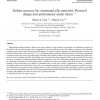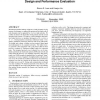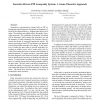14 search results - page 1 / 3 » Designing less-structured P2P systems for the expected high ... |
P2P
2005
IEEE
13 years 10 months ago
2005
IEEE
We address the problem of highly transient populations in unstructured and loosely-structured peerto-peer systems. We propose a number of illustrative query-related strategies and...
TON
2008
13 years 4 months ago
2008
Abstract--We address the problem of highly transient populations in unstructured and loosely-structured peer-to-peer systems. We propose a number of illustrative query-related stra...
CN
2006
13 years 4 months ago
2006
Measurement studies indicate a high rate of node dynamics in p2p systems. In this paper, we address the question of how high a rate of node dynamics can be supported by structured...
SIGMETRICS
2004
ACM
13 years 10 months ago
2004
ACM
Measurement studies indicate a high rate of node dynamics in p2p systems. In this paper, we address the question of how high a rate of node dynamics can be supported by structured...
ICPP
2007
IEEE
13 years 11 months ago
2007
IEEE
– Anonymous communication systems built on P2P infrastructures using anonymity forwarders are frequently affected by the churn problem, i.e. frequent joins and leaves of nodes. T...



